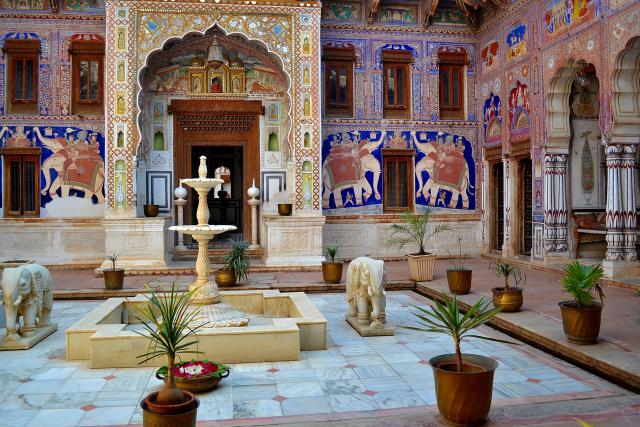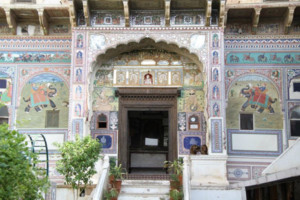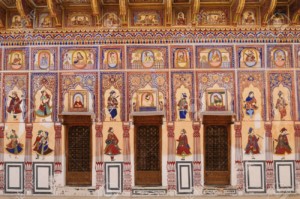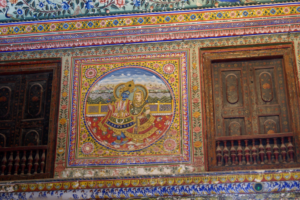TRAVEL
Shekhawati Havelis: Open-Air Gallery In Rajasthan

The Shekhawati region of Rajasthan must be included on your itinerary if you’re an art lover or even someone who’s into architecture and history. This unique region is often referred to as the world’s largest open-air art gallery stretching approximately around 13,784 sq km. The old Havelis (mansions), with walls adorned with intricately painted frescoes, are the main attraction in the Shekhawati region.
It was established in the 18th century along a caravan trade route and ruled by the Shekhawat Rajputs. The region was a prosperous one, with over 100 villages, and 50 forts and palaces. The region prospered because of the Bania (merchant) and Marwari community. As both of these communities belonged to the ethnic trading groups, and due to the low tax rate prevalent here they settled down at this region for trading spices, cotton, and opium. These merchants grew richer and commissioned artists to paint frescoes on their homes as a sign of opulence. Painted Havelis cropped up all over the desert landscape. The art was kept alive for nearly 300 years.

Most of these traditional Havelis had two stories, with an almost similar architectural style that illustrates ornately decorated residences which enclose either one or more open courtyards highlighting fanciful, picture of the countryside. One courtyard was for men and their business dealings, other was for women and some were for cooking and animal stables. Every inch of the mansion had step wells and temples, including the ceiling, that were decorated with colorful murals. The merchants left no stone unturned in adoring the mansions with a distinct and regal look, having ornately carved wooden entrances with pompous mirror work.

Shekhawati region’s appeal and mystique is due to the Fresco artwork (meaning painting done with traditional pigments made out of the vegetables and other minerals on wet or fresh plaster) being found in this tiny towns and villages of Shekhawati that encompass the world’s largest concentration of magnificent frescoes in a single region which are so fascinating and showcases artists creativity combined with traditional subjects, of mythology, religious scenes or images of the family, depicting contemporary concerns, etc. Also, brand-new inventions and accounts of current events, like an airplane, gramophone, ships, hot air balloon, trains etc. painted on the outer walls including, the Belgian glasswork on the doors of a Havelis incorporated with paintings of Lord Krishna and his gopis in shiny gold would surely impress the visitors to a great extent and be a delightful sight, as most of these are what painters rendered straight from their imagination. The painters have used a beautiful combination of shades like copper, blue, maroon, red and yellow to adorn the walls and ceilings.

Shekhawati prospered until the early 20th century where each Haveli symbolized its owner’s success. Some of India’s most prosperous business families like the Oswals, Mittals, Birlas, Goenkas, Singhanias, and Agarwal, have their roots here in this region. But when the merchants shifted to new trading centers like Madras, Calcutta, and Mumbai, these Havelis were abandoned locked up and neglected.
Thankfully, in 1999, the Nand Lal Devra Haveli, which was built in 1802, was acquired by French artist Nadine Le Prince. He restored and preserved the Haveli and now it is named Nadine Le Prince Cultural Centre. Besides this, many other Havelis have been restored and converted into museums. A few of them have been converted into a heritage hotel with the soul aim of conserving and promoting the Shekhawati as a popular tourist destination.
Drive down to Shekhawati, as it is only 258 km from Delhi via Narnaul road. See things at your own pace. The nearest airport here is at Jaipur. Nawalgarh or Mandawa town is the ideal town for stay option here. Book a hotel or Lodge well in advance.
You can also visit some surrounding area like Parasrampura to look at the most beautiful and oldest paintings in the region. Nawalgarh is worth a visit for its Podar Museum. Mandawa has the Mandawa Fort while Churu, Sikar, Bissau, Jhunjhunu and Ramgarh towns offer a lot to see from step wells (baoris), cenotaphs (chhatris), temples to forts and palaces apart from Havelis.
